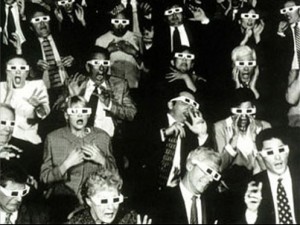As part of the “rhetorical situation” most students either pick up on or are explicitly taught, “audience” looms large as the writer tries to predict exactly what will move those who hear or read the work. Other pieces enter the picture, too—purpose, occasion, for example—and this triumvirate serves as a kind of cloud into which the writer uploads words.
In classical rhetoric (or, is that Classical Rhetoric), the role of an audience is addressed in the works of Aristotle, Cicero, Plato, Socrates (via Plato of course), and a few “unknown authors.” Although the  question of “audience” figures into all these authors’ works, the question of how or even whether one should attend to one’s audience was rather more fractured: For some the audience may be filled with dimwits who hold untrained opinions (doxa), and so the model orator would address them by taking the high road of “knowledge” and truth. In short, he should teach virtue and deliver wisdom (and therefore enlighten those ignorant souls; Socrates, as the mouthpiece of Plato, never did think much of the hoi polloi: see Plato,Gorgias). For others, namely Aristotle, audience was figured with somewhat more nuance; his taxonomy of audiences includes their demographics (their family and fortune; their age; they are assumed to be men) their emotional state, and their character type (see Book 2 of Rhetoric). Aristotle identifies general types of audiences—the passive spectator, the engaged public, and the judge (hence the branches of rhetoric: deliberative, epideictic, and forensic). Yet Aristotle did not actively link invention or style to the characteristics of the audience, although knowledge of the audience does play a role in the construction of some figures. While Plato seems to argue that one makes an audience by lifting them up to the level of the (non-sophist) rhetorician, Plato describes a rhetor whose role is to provide wisdom and knowledge or to persuade the audience to accept an established norm or truth.
question of “audience” figures into all these authors’ works, the question of how or even whether one should attend to one’s audience was rather more fractured: For some the audience may be filled with dimwits who hold untrained opinions (doxa), and so the model orator would address them by taking the high road of “knowledge” and truth. In short, he should teach virtue and deliver wisdom (and therefore enlighten those ignorant souls; Socrates, as the mouthpiece of Plato, never did think much of the hoi polloi: see Plato,Gorgias). For others, namely Aristotle, audience was figured with somewhat more nuance; his taxonomy of audiences includes their demographics (their family and fortune; their age; they are assumed to be men) their emotional state, and their character type (see Book 2 of Rhetoric). Aristotle identifies general types of audiences—the passive spectator, the engaged public, and the judge (hence the branches of rhetoric: deliberative, epideictic, and forensic). Yet Aristotle did not actively link invention or style to the characteristics of the audience, although knowledge of the audience does play a role in the construction of some figures. While Plato seems to argue that one makes an audience by lifting them up to the level of the (non-sophist) rhetorician, Plato describes a rhetor whose role is to provide wisdom and knowledge or to persuade the audience to accept an established norm or truth.
In the millennia since, rhetoric has created the “reasonable man” standard, in which one man stands for the whole audience, and audience itself has come to be generalized as “the consumer.”
When I was an undergrad, most of my professors didn’t address audience explicitly, and the assumption clearly was that I was writing for them. The occasional professor who bandied “write for your peers” was always eyed somewhat suspiciously as disingenuously democratic because we all knew that at the end of the day said professor was grading the work. I never imagined more than one person as my audience, even when writing graduate school application essays or, later, conference papers and articles, because I never knew what this audience was comprised of. I just imagined this “reasonable man,” and hoped he would accept my application, paper proposal, or essay.
When we ask student writers to write for a particular audience, how do we define that audience? Assuming the “reasonable person” standard would seem to generalize that audience into inconsequence. If the audience is just the instructor, well, then, students will try to write in what they believe is a language that we understand. If the audience is peers, how would the writing change? Anyone trying to explore the relationship between war imagery and Arthurian legend is not going to address a peer as “u” because the topic and the occasion wouldn’t be something to text or Tweet.
Is any audience ever so homogeneous? Who defines what constitutes a reasonable person? Check recent presidential race polls if you want to know how different people define “reasonable.” How would we advise this student to write for a mixed audience of, say, hawks and doves in this examination of war imagery? Could a student writer repurpose an essay like this for another audience? Perhaps we have overplayed audience and could look more closely at purpose and context. Our attempts to suggest different audiences for essays written in our First-Year Writing classes do seem disingenuous to students as they also know who has holds the power for a grade, and their work in that light plays into the idea that an essay for a class is a transaction between instructor (consumer) and writer. Perhaps if we turn toward context, we can help students refigure the classroom as a legitimate space for producing knowledge that benefits all in the class, and in that context, their purpose may well begin to reorient itself toward doing something meaningful.